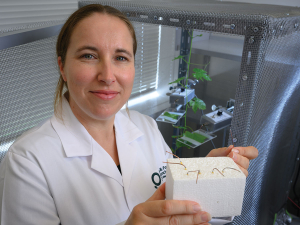Fussy children might be frustrating, but fussy mealybugs could help protect the New Zealand wine industry from grapevine leafroll-associated virus 3.
"Can we identify what makes some grapevines taste to them like chocolate biscuits and others taste like Brussels sprouts?" asked Lincoln University PhD student Michelle Thompson at the New Zealand Wine Centre Scientific Research Conference in June. "This can support breeding programmes to maximise mealybug resistance in out plants... We want them to either go hungry or decide to feed on something else."
Michelle, who was awarded the top student presentation at the conference in Blenheim, has been working with Plant & Food Research on a project using electropenetrography (EPG) to research the feeding behaviours of Citrophilus mealybug on Sauvignon Blanc plants.
She explained the meticulous process of removing the dorsal wax off 2mm mealybugs to attach a fine gold wire, looped to increase surface coverage, linked to an electrical circuit. The bug is placed on the third or fourth expanded leaf of a young Sauvignon Blanc vine and a light voltage is applied to the soil around the plant. Over a 48 hour period, Michelle charts the phases of feeding, from the mealybug investigating the leaf to puncturing the tissue with its stylet, and eventually reaching the xylem or phloem, where it can ingest for several hours. Michelle, who charts intermittent probing and non-probing phases as the electrical current readings change, says previous research has shown that ingestion for six to eight hours is sufficient for mealybug to infect a vine with leafroll virus.
It is also known that Citrophilus mealybug prefer feeding on some grapevines more than others, she says. “Like human children there are some things they really like to eat. There are other things they might taste and then refuse to eat any more. Or might look at or touch and choose not to eat.” The objective of her study is to investigate whether the compounds produced by some grapevines would deter mealybug from ingesting – the Brussels sprout effect – thus enabling breeding programmes to target those secondary compounds to offer natural resistance to the mealybug.
Dr Stewart Field, from Nelson Marlborough Institute of Technology, says the student presentations were particularly impressive at the conference, and judging the University of Aucklandsponsored Best Student Awards was no easy task. Rebecca Strange, from University of Auckland, was the runner-up.
Michelle’s research is part of the smart, adaptive grapevine rootstocks for a changing world programme, funded by the Ministry for Business Innovation and Employment’s Endeavour Fund. Her supervisors are Amber Parker, Olaf Schelezki and Philippa Barrell. Adriana Najar-Rodriguez acts as an advisor.












